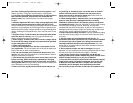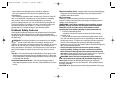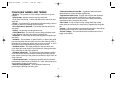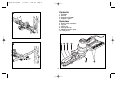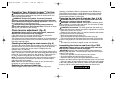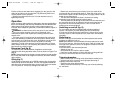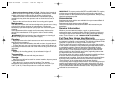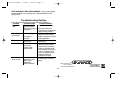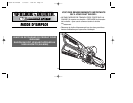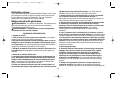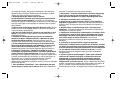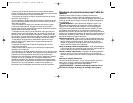
11
Pull the chain bar and chain back, engaging it in the groove in the
chain bar and then over the sprocket (14) positioning teeth in the
correct position on the sprocket.
- Replace the chain access cover (12) and retention nuts (11)
tightening securely.
Operation
Never operate a chain saw that is damaged or improperly adjusted or
that is not completely and securely assembled. Be sure that the saw
chain stops moving when the power control system triggers are
released. Never adjust the guide bar or saw chain when the engine is
operating.
WARNING: Let the tool work at its own pace. Do not overload.
- Carry out regular cleaning of the unit as described in the
maintenance section and in particular cleaning inside the chain
access cover.
- The lower guard (7) and top jaw (6) are designed to close when
one of the handles is released or when the piece of branch being
cut has been cut. If this does not occur, discontinue use of the tool
and remove the power cord. Check if any debris is blocking
movement. To help in this process it may be necessary to remove
chain access cover(12). If on assembly the problem is still present
take the unit to a service center.
Extension Cord (fig. E)
To reduce the risk of disconnection of appliance cord from the
extension cord during operation make a knot as shown in Figure E on
page 8.
NOTE: Always keep the cord away from the cutting area and position
the cord so that it will not be caught on branches, and other material,
during cutting.
Oiling (fig. F)
A high quality bar and chain oil or SAE30 weight motor oil should be
used for chain and bar lubrication. The use of a vegetable based bar
and chain oil is recommended when pruning trees. Never use waste
oil or very thick oil. These may damage your chain saw.
- Before first use and every ten minutes of use you must oil the
product with the recommended chain oil. Open the oiling cover (10)
and insert the bottle into the oil filling hole (15) apply pressure to the
bottle once to dispense oil.
- This should be adequate for about 10 minutes of cutting
depending upon cutting speed and type of wood.
- The hole feeds the oil through to the chain onto the chain bar and
an excessive amount of oil applied to the unit could mean the oil
drips from the unit around the jaw area. This is normal and is
nothing to be concerned about.
Switching on and off (fig. G)
For your safety, this tool is equipped with a double switching
system. This system prevents starting the tool inadvertently.
A chain saw is intended for two-handed use. Serious injury to the
operator, helpers, and/or bystanders can result from one-handed
operation.
Switching on
Ensure a firm grip on the handles and then squeeze both switch
actuators to switch the unit on.
Note: Both switches must be activated for the product to be used.
Do not force the tool - allow it to do the work. It will do a better and
safer job at the speed for which it is designed. Excessive force will
stretch the chain.
If the saw chain or bar becomes jammed:
- Switch the tool off.
- Disconnect the tool from the power supply.
- Open the cut with wedges to relieve the strain on the guide bar.
Do not try to wrench the saw free. Start a fresh cut.
Trimming branches
- Make sure the tool is running at full speed before making a cut.
- Hold the tool firmly in place to avoid possible bouncing or
sideways movement of the tool.
- Guide the tool using light pressure.
- Always cut down from the top. This way you will avoid pinching
the saw chain.
479970-00 LP1000 9/14/05 1:00 PM Page 11



